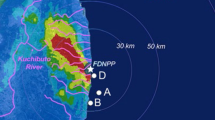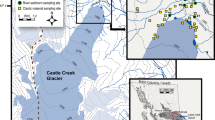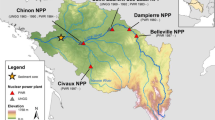Abstract
SIGNIFICANT levels of caesium-137 from tests of nuclear weapons were first detected in the atmosphere in 1954; the maximum deposition1 occurred in 1963. It would be expected that a continuously accumulating lake sediment would incorporate 137Cs from fallout in a distribution pattern similar to that found from regular analysis of rain and air-borne particulate matter, provided that there has been no significant mixing in the sediment by diffusion or by the bottom fauna. Sediments from five lakes of the English Lake District have been analysed for 137Cs in order to test this hypothesis (Table 1).
This is a preview of subscription content, access via your institution
Access options
Subscribe to this journal
Receive 51 print issues and online access
$199.00 per year
only $3.90 per issue
Buy this article
- Purchase on Springer Link
- Instant access to full article PDF
Prices may be subject to local taxes which are calculated during checkout
Similar content being viewed by others
References
Cambray, R. S., Fisher, E. M. R., Brooks, W. L., and Peirson, D. H., Radioactive Fallout in Air and Rain: Results to the Middle of 1971, AERE-R6923 (HMSO, London, 1971).
Mackereth, F. J. H., Limnol. Oceanog., 14, 145 (1969).
Salmon, L., and Creevy, M. G., Nuclear Techniques in Environmental Pollution, 47, Proc. Salzburg Symp. (IAEA, Vienna, 1971).
Ravera, O., and Premazzi, G., Publn. No. 679 (Biology Directorate, Commission of the European Communities, 1971).
Berg, K., Kgl. Danske Videnskab. Selskab Skrifter, 8, 1 (1938).
Tutin, W., Mem. Ist. Ital. Idrobiol., 8 (Suppl.), 467 (1955).
Lund, J. W. G., J. Ecol., 42, 151 (1954).
Davis, M. B., Science, 162, 796 (1968).
Stockner, J. G., and Lund, J. W. G., Limnol. Oceanog., 15, 41 (1970).
Pennington, W., Phil. Trans. Roy. Soc., B, 233, 137 (1947).
Pennington, W., Proc. Roy. Soc., B, 161, 310 (1965).
Franks, J. W., and Pennington, W., New Phytol., 60, 27 (1961).
Round, F. E., New Phytol., 60, 43 (1961).
Goulden, C. E., Arch. Hydrobiol., 60, 1 (1964).
Harmsworth, R. V., Ecol. Monographs, 38 (3), 223 (1968).
Evans, G. H., New Phytol., 69, 821 (1970).
Stockner, J. G., Verh. Int. Ver. Limnol., 18, 1, 1018 (1972).
Pennington, W., New Phytol., 42, 1 (1943).
Mackereth, F. J. H., Earth Planet. Sci. Lett., 12, 332 (1971).
Mackereth, F. J. H., Proc. Roy. Soc., B, 161, 295 (1965).
Meterological Office, British Rainfall Supplement 1961–1965 (HMSO, London, 1971).
Author information
Authors and Affiliations
Rights and permissions
About this article
Cite this article
PENNINGTON, W., TUTIN, T., CAMBRAY, R. et al. Observations on Lake Sediments using Fallout 137Cs as a Tracer. Nature 242, 324–326 (1973). https://doi.org/10.1038/242324a0
Received:
Revised:
Issue Date:
DOI: https://doi.org/10.1038/242324a0
This article is cited by
-
Marine inundation history during the last 3000 years at Lake Kogare-ike, a coastal lake on the Pacific coast of central Japan
Progress in Earth and Planetary Science (2023)
-
137Cs distribution on the territory of Romania 30 years after Chernobyl accident
Environmental Monitoring and Assessment (2023)
-
How Long a Tropical Mountainous Lake Can Survive? Inferences from Geochemistry and Radiometric Measurements of Pookode Lake, Kerala, India
Journal of the Geological Society of India (2023)
-
Transfer of industrial contaminants from the inner to the outer region of Sepetiba Bay (SE Brazil) by dredge spoil dumping activities: a temporal record
Environmental Earth Sciences (2023)
-
Assessing the impact of land use and climate changes on the sedimentary regime of Valasht mountainous Lake (Iran) using radionuclide techniques
Environmental Earth Sciences (2022)
Comments
By submitting a comment you agree to abide by our Terms and Community Guidelines. If you find something abusive or that does not comply with our terms or guidelines please flag it as inappropriate.



